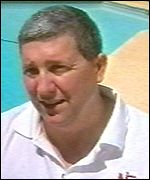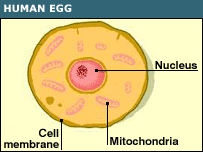
Cloned Human Embryo
Judson Somerville broke his spine in a cycling accident, leaving him paralysed. Scientist Jose Cibelli took cells from Somerville and, having removed the nucleus of an ovum, implanted the nucleus of one of his cells, creating the first human embryo clone. This was recorded and shown on the BBC's How to Build a Human series. Cibelli was unsuccessful in this attempt to cure Somerville, but his work continues.
Human-Animal Hybrid Embryo
In January 2007, the HFEA announced that it would consult the public before deciding whether to allow researchers to create hybrid human-animal embryos. Scientists claim this work could lead to a cure for Alzheimers.
 Embryo with three parents
Embryo with three parents
Scientists are trying to prevent a mother passing mitochondrial diseases on to her child. After her egg is fertilised with her husband's sperm, the nucleus is removed and put into the egg of another woman. The resulting embryo has DNA from all three participants but, if allowed to grow, would resemble the 'parents' as the mitochondrial DNA does not dictate hair or eye colour etc.

